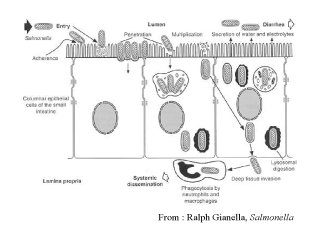|
|
|
|
front |1 |2 |3 |4 |5 |6 |7 |8 |9 |10 |11 |12 |13 |14 |15 |16 |17 |18 |19 |20 |21 |22 |23 |24 |25 |26 |27 |28 |29 |30 |review |
 |
This is a schematic of invasion of
Salmonella through the small intestines.
Salmonella tend to adhere and
colonize this part of the intestine, and can spend several days
multiplying, and slowly penetrating into the columnar cells and the Peyers
Patches, which are collections of lymphoid tissue in the intestines.
Indeed, S. typhi typically has a 10 –14 day incubation period,
i.e. a 10 – 14 day delay between ingestion of the organism, and
development of signs and symptoms of illness.
During this 10 – 14 days this process or replication, adherence,
and penetration steadily progresses.
S. Typhi can live and reproduce
within the phagocytic cells of human immune system.
These immune cells circulate throughout the body, and so they
provide a way for the bacteria to gain access to the blood stream and
circulate throughout the body.
|